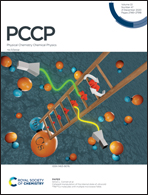X-Ray attenuation and image contrast in the X-ray computed tomography of clathrate hydrates depending on guest species†
Abstract
In this study, X-ray imaging of inclusion compounds encapsulating various guest species was investigated based on the calculation of X-ray attenuation coefficients. The optimal photon energies of clathrate hydrates were simulated for high-contrast X-ray imaging based on the type of guest species. The proof of concept was provided by observations of Kr hydrate and tetra-n-butylammonium bromide (TBAB) semi-clathrate hydrate using absorption-contrast X-ray computed tomography (CT) and radiography with monochromated synchrotron X-rays. The radiographic image of the Kr hydrate also revealed a sudden change in its attenuation coefficient owing to the K-absorption edge of Kr as the guest element. With a photon energy of 35 keV, X-ray CT provided sufficient segmentation for the TBAB semi-clathrate hydrate coexisting with ice. In contrast, the simulation did not achieve the sufficient segmentation of the CH4 and CO2 hydrates coexisting with water or ice, but it revealed the capability of absorption-contrast X-ray CT to model the physical properties of clathrate hydrates, such as Ar and Cl2 hydrates. These results demonstrate that the proposed method can be used to investigate the spatial distribution of specific elements within inclusion compounds or porous materials.



 Please wait while we load your content...
Please wait while we load your content...